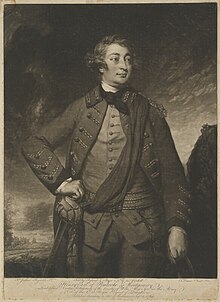Henry Herbert, 10th Earl of Pembroke
The Earl of Pembroke | |
|---|---|
 | |
| Lord of the Bedchamber | |
| In office 1761–1763 | |
| Monarch | George III |
| Preceded by | The Earl of Hyndford |
| Succeeded by | The Earl of Pomfret |
| Personal details | |
| Born | 3 July 1734 |
| Died | 26 January 1794 (aged 59) |
| Nationality | British |
| Spouse | Lady Elizabeth Spencer |
| Children | George Augustus Herbert, 11th Earl of Pembroke, 8th Earl of Montgomery Charlotte Herbert |
| Parent(s) | Henry Herbert, 9th Earl of Pembroke Mary FitzWilliam |
| Education | Eton College |
| Occupation | Cavalry officer |

Henry Herbert, 10th Earl of Pembroke (3 July 1734 – 26 January 1794) was a British Army officer, peer, politician and courtier who served as a Lord of the Bedchamber to King George III in 1769. He was renowned for his skill in horse training. Captain James Cook's famous ship, HMS Endeavour, was formerly MS Earl of Pembroke, launched in 1765 and named after the 10th Earl.[1]
Origins
[edit]He was the son and heir of Henry Herbert, 9th Earl of Pembroke (1693–1749), of Wilton House, by his wife Mary FitzWilliam, a daughter of Richard FitzWilliam, 5th Viscount FitzWilliam and Frances Shelley. Through this marriage his son inherited the substantial FitzWilliam properties in Dublin and FitzWilliam House at Richmond Green in Surrey, which he renamed "Pembroke House".[2]
Career
[edit]He was educated at Eton College, and was styled Lord Herbert until he succeeded to his father's earldom in 1749. He became a Lieutenant-General in the Army, later Colonel of the 1st Regiment of Dragoons.
He became an authority on breaking cavalry horses and in 1755 built an indoor Riding School at Wilton House and commissioned 55 paintings of military riding exercises which now hang in the Large Smoking Room at Wilton. In 1756 he married the 19-year-old Lady Elizabeth Spencer (January/March 1737–30 April 1831), a daughter of Charles Spencer, 3rd Duke of Marlborough by his wife Elizabeth Trevor. As his London townhouse he purchased 40 Queen Anne Street, Marylebone which he used for entertaining during the "London season". This must have been before 1760, as early that year he was despatched with his regiment to Germany to take part in the Seven Years' War as a Major-General in command of the Cavalry Brigade in Germany until the following year.
In 1761, he wrote the British Army's manual on riding, Military Equitation: or A Method of Breaking Horses, and Teaching Soldiers to Ride, which had already reached a 4th edition by 1793, and his methods were adopted throughout the British cavalry.
As Lord Lieutenant of Wiltshire he was responsible for reforming the Wiltshire Militia and commissioning its officers when it was embodied in 1758. In 1770 when the Colonel and many of the officers resigned in protest at Pembroke's promotion of a junior officer to the vacant Lieutenant-Colonelcy, Pembroke took command himself as colonel. He relinquished the command in 1778 on the eve of the regiment's next embodiment during the American War of Independence.[3]
Henry was appointed a Lord of the Bedchamber to George III in 1769, and advanced to the rank of General in 1782.
Marriage and children
[edit]On 23 March 1756 he married the 19-year-old Lady Elizabeth Spencer (January/March 1737–30 April 1831), a daughter of Charles Spencer, 3rd Duke of Marlborough by his wife Elizabeth Trevor. By Elizabeth he had issue as follows:
- George Augustus Herbert, 11th Earl of Pembroke, 8th Earl of Montgomery (1759–1827), son and heir, who married firstly in 1787, Elizabeth Beauclerk and secondly in 1808 Countess Catherine Romanovitch.
- Charlotte Herbert (1773–1784), who died from consumption at age 10.
Mistresses
[edit]
He had several mistresses amongst whom were:
- Kitty Hunter, whom he met on his return to England in January 1762, and, disguised as a sailor, eloped with to the Low Countries having left a note for his wife. Horace Walpole commented:
- "As Pembroke a horseman by most is accounted
- 'Tis not strange his Lordship a Hunter has mounted."
- On Henry's recall to the Army in Germany, the pregnant Kitty returned to England and on 23 November 1762[4] gave birth to their child Augustus Retnuh Reebkomp (died 6 February 1797) whose middle name spelt "Hunter" backwards and whose surname was an anagram of "Pembroke". He later adopted the surname "Montgomery". Henry returned to England in February 1763 and was reconciled to his wife in March.
- Second mistress, with whom Henry had another affair in Venice in 1768, apparently carrying the lady off on the very night of her wedding to someone else. She gave birth to their illegitimate child Caroline Medkaff that year or the next.
Death
[edit]He died at Wilton at the age of 59.
Notes
[edit]- ^ Debrett's Peerage of the United Kingdom of Great Britain and Ireland. G. Woodfall. 1828. p. 98.
- ^ "Old Palace Lane to the Old Deer Park Gates".
- ^ Kenrick, pp. 295, 303.
- ^ Baptised 25 November 1762
Sources
[edit]- Images of Kitty Hunter
- Henry, Elizabeth and George: Letters and Diaries of Henry, 10th Earl of Pembroke and his Circle (1734–80), 16th Earl, 1939, repub as: The Pembroke Papers vol. I (1734–80), 1942–50.
- The Pembroke Papers vol. II (1780–94), 16th Earl, 1950, [EUL] 9(42073) Pem.
- Col N.C.E. Kenrick, The Story of the Wiltshire Regiment (Duke of Edinburgh's): The 62nd and 99th Foot (1756–1959), the Militia and the Territorials, the Service Battalions and all those others who have served or been affiliated with the Moonrakers, Aldershot: Gale & Polden, 1963.
